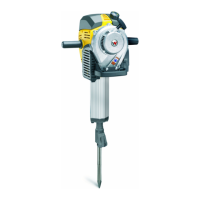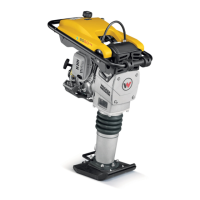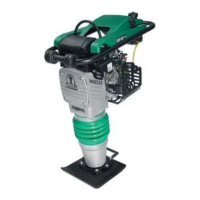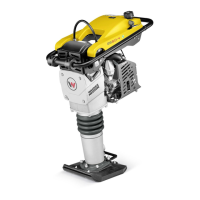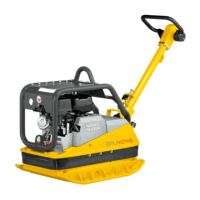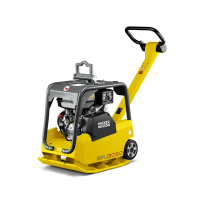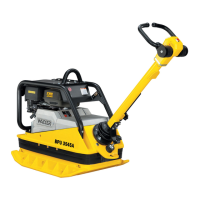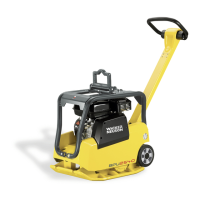Do you have a question about the Wacker Neuson BH24 and is the answer not in the manual?
Explains warning symbols and notes used in the operator's manual for safety and information.
Provides information on how to find your local Wacker Neuson representative via the website.
Explains how to identify the machine using nameplate data and provides a table for recording information.
Outlines machine safety principles, proper use, and consequences of improper use.
Covers structural modifications, operation requirements, and general safety for operation and maintenance.
Addresses malfunctions, spare parts, liability exclusions, manual handling, and country regulations.
Specifies qualifications, responsibilities, and training needed for safe machine operation.
Details recommended work clothing and personal protective equipment (PPE) for operator safety.
Provides instructions for safely preparing, transporting, and lifting the machine.
Covers safety in the work area, checks before starting, and maintaining vertical stability.
Highlights cautions for hot/moving/toxic parts, safe storage, and preventing endangerment.
Safety guidelines for hand machines and combustion engines, including refueling and damage checks.
Covers fire prevention, refueling safety, and hazards of operating in enclosed spaces.
Discusses safety related to maintenance work, engine shutdown, and emission control notes.
Guidelines for safe handling of operating fluids and cleaning procedures for the machine.
Describes essential safety devices like the burn protector and warns against their modification or removal.
Explains the importance of labels and lists the first five safety and information labels with their descriptions.
Continues the description of safety and information labels, covering items 6 through 10.
States that the machine should only be used as intended, referring to the safety section.
Explains the working principle of the demolition hammer, including its engine, percussion system, and vibration decoupling.
Identifies key components of the machine using a diagram and a table, including the recoil starter.
Provides detailed descriptions of operator controls such as the gas handle, fuel tap, choke, and fuel pump.
Outlines necessary preparations before transporting the machine, including switching off the engine and emptying the fuel system.
Lists essential checks to perform on the machine before beginning work, such as checking for damage and fuel level.
Explains how to adjust the machine for operation with or without an external remote cut-off device.
Provides instructions on how to safely change tools, including general notes and a procedure for inserting a tool.
Offers work tips for starting the machine and notes for operation in cold conditions to prevent clutch wear.
Details the steps and components involved in starting the engine, emphasizing safety regarding the fueling area.
Outlines preparatory steps for starting the engine, including positioning the machine, opening the fuel tap, and using the choke.
Provides a step-by-step guide for starting the engine, including pulling the starter rope and managing the choke.
Explains how to operate the machine for processing material, including holding techniques and handling stuck tools.
Details the procedure for switching off and properly setting down the machine after use.
Discusses normal maintenance, replacement, and repair of emission control devices, noting warranty requirements.
Outlines who is qualified to perform maintenance work described in the manual.
Presents a schedule of maintenance tasks, indicating frequency (daily, every 20 hrs, monthly, annually) for various checks.
Describes the benefits of performing maintenance in a workshop and details the process of cleaning the machine.
Provides safety warnings and instructions for refueling the machine, emphasizing fire and health hazards.
Details the process of topping up the fuel tank, including preparations and notes on unscrewing the fuel cap.
Guides the user through removing, checking, cleaning, and installing the air cleaner cartridge, with a notice on engine wear.
Explains the procedure for lubricating the machine using the zerk fitting, including how to operate the grease gun.
Provides instructions for checking, cleaning, and replacing the spark plug, including safety precautions for hot parts.
Details how to check the tool holder for wear by measuring tool play and when replacement is necessary.
Outlines steps for preparing the machine for long-term storage, including emptying the fuel system and cleaning.
Describes the Wacker Neuson truck accessory, its proper use, and restrictions.
Provides instructions and cautions for safely placing the demolition hammer onto the truck accessory.
Lists detailed technical specifications for the BH 23 model, including dimensions, weight, and performance metrics.
Provides technical specifications for the drive engine of the BH 23, including manufacturer, type, displacement, and fuel/oil details.
Lists detailed technical specifications for the BH 24 model, including dimensions, weight, and performance metrics.
Details technical specifications for the BH 24 Low Vib model, covering dimensions, weight, and vibration values.
Provides technical specifications for the drive engine of the BH 24 Low Vib, including manufacturer, type, and fuel/oil details.
Lists detailed technical specifications for the BH 65 model, including dimensions, weight, and performance metrics.
Provides technical specifications for the drive engine of the BH 65, including manufacturer, type, and fuel/oil details.
Introduces emission regulations and explains exhaust and evaporative emissions and potential problems.
Details the limited defect warranty for Wacker Neuson emission control systems, including coverage and duration.
Lists components covered under the emission control system warranty and specifies systems like fuel metering, exhaust, air induction, and ignition.
Outlines what is not covered by the emission control warranty, including owner abuse, neglect, and non-authorized parts.
Explains the owner's warranty responsibility for maintenance and the procedure for making a warranty claim.
Explains the use of oxygenated fuels, approved percentages, and potential warranty implications.
Explains warning symbols and notes used in the operator's manual for safety and information.
Provides information on how to find your local Wacker Neuson representative via the website.
Explains how to identify the machine using nameplate data and provides a table for recording information.
Outlines machine safety principles, proper use, and consequences of improper use.
Covers structural modifications, operation requirements, and general safety for operation and maintenance.
Addresses malfunctions, spare parts, liability exclusions, manual handling, and country regulations.
Specifies qualifications, responsibilities, and training needed for safe machine operation.
Details recommended work clothing and personal protective equipment (PPE) for operator safety.
Provides instructions for safely preparing, transporting, and lifting the machine.
Covers safety in the work area, checks before starting, and maintaining vertical stability.
Highlights cautions for hot/moving/toxic parts, safe storage, and preventing endangerment.
Safety guidelines for hand machines and combustion engines, including refueling and damage checks.
Covers fire prevention, refueling safety, and hazards of operating in enclosed spaces.
Discusses safety related to maintenance work, engine shutdown, and emission control notes.
Guidelines for safe handling of operating fluids and cleaning procedures for the machine.
Describes essential safety devices like the burn protector and warns against their modification or removal.
Explains the importance of labels and lists the first five safety and information labels with their descriptions.
Continues the description of safety and information labels, covering items 6 through 10.
States that the machine should only be used as intended, referring to the safety section.
Explains the working principle of the demolition hammer, including its engine, percussion system, and vibration decoupling.
Identifies key components of the machine using a diagram and a table, including the recoil starter.
Provides detailed descriptions of operator controls such as the gas handle, fuel tap, choke, and fuel pump.
Outlines necessary preparations before transporting the machine, including switching off the engine and emptying the fuel system.
Lists essential checks to perform on the machine before beginning work, such as checking for damage and fuel level.
Explains how to adjust the machine for operation with or without an external remote cut-off device.
Provides instructions on how to safely change tools, including general notes and a procedure for inserting a tool.
Offers work tips for starting the machine and notes for operation in cold conditions to prevent clutch wear.
Details the steps and components involved in starting the engine, emphasizing safety regarding the fueling area.
Outlines preparatory steps for starting the engine, including positioning the machine, opening the fuel tap, and using the choke.
Provides a step-by-step guide for starting the engine, including pulling the starter rope and managing the choke.
Explains how to operate the machine for processing material, including holding techniques and handling stuck tools.
Details the procedure for switching off and properly setting down the machine after use.
Discusses normal maintenance, replacement, and repair of emission control devices, noting warranty requirements.
Outlines who is qualified to perform maintenance work described in the manual.
Presents a schedule of maintenance tasks, indicating frequency (daily, every 20 hrs, monthly, annually) for various checks.
Describes the benefits of performing maintenance in a workshop and details the process of cleaning the machine.
Provides safety warnings and instructions for refueling the machine, emphasizing fire and health hazards.
Details the process of topping up the fuel tank, including preparations and notes on unscrewing the fuel cap.
Guides the user through removing, checking, cleaning, and installing the air cleaner cartridge, with a notice on engine wear.
Explains the procedure for lubricating the machine using the zerk fitting, including how to operate the grease gun.
Provides instructions for checking, cleaning, and replacing the spark plug, including safety precautions for hot parts.
Details how to check the tool holder for wear by measuring tool play and when replacement is necessary.
Outlines steps for preparing the machine for long-term storage, including emptying the fuel system and cleaning.
Describes the Wacker Neuson truck accessory, its proper use, and restrictions.
Provides instructions and cautions for safely placing the demolition hammer onto the truck accessory.
Lists detailed technical specifications for the BH 23 model, including dimensions, weight, and performance metrics.
Provides technical specifications for the drive engine of the BH 23, including manufacturer, type, displacement, and fuel/oil details.
Lists detailed technical specifications for the BH 24 model, including dimensions, weight, and performance metrics.
Details technical specifications for the BH 24 Low Vib model, covering dimensions, weight, and vibration values.
Provides technical specifications for the drive engine of the BH 24 Low Vib, including manufacturer, type, and fuel/oil details.
Lists detailed technical specifications for the BH 65 model, including dimensions, weight, and performance metrics.
Provides technical specifications for the drive engine of the BH 65, including manufacturer, type, and fuel/oil details.
Introduces emission regulations and explains exhaust and evaporative emissions and potential problems.
Details the limited defect warranty for Wacker Neuson emission control systems, including coverage and duration.
Lists components covered under the emission control system warranty and specifies systems like fuel metering, exhaust, air induction, and ignition.
Outlines what is not covered by the emission control warranty, including owner abuse, neglect, and non-authorized parts.
Explains the owner's warranty responsibility for maintenance and the procedure for making a warranty claim.
Explains the use of oxygenated fuels, approved percentages, and potential warranty implications.
| Brand | Wacker Neuson |
|---|---|
| Model | BH24 |
| Category | Power Tool |
| Language | English |
